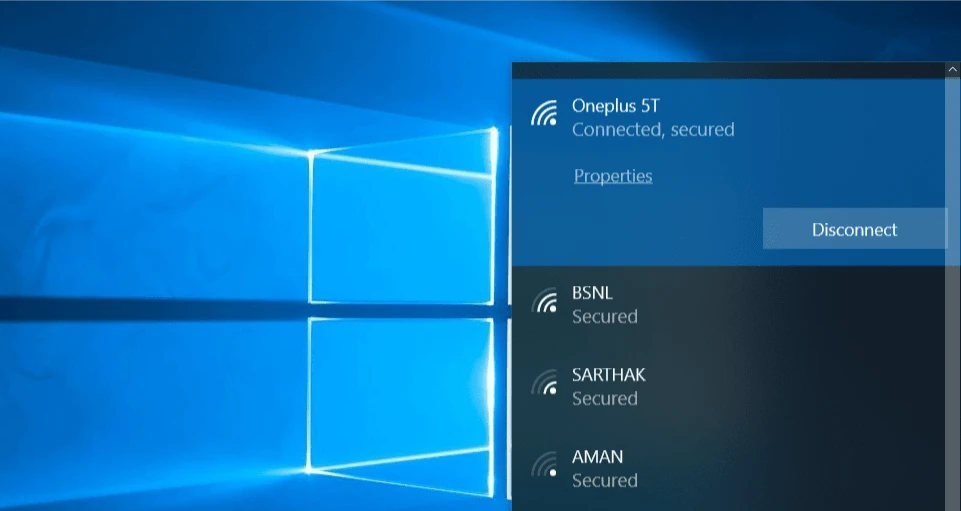Ethernet and WiFi are two ways to connect to the internet. Ethernet is a wired connection, while WiFi is a wireless connection. The Ethernet connection is typically faster and more reliable than WiFi, but it requires a cable to be connected to your computer or device.
Sometimes, you may notice that the Ethernet icon is showing instead of the WiFi icon on your computer or device. This can happen due to an issue with the network adapter on your PC. However, it can be fixed with the Network Adapter troubleshooter.
To run the Network Adapter troubleshooter, you first need to open the Settings app on your computer or device. From there, scroll down and click on the Troubleshoot tab. Right-click the item with the name ‘Ethernet’ and the symbol for a network cable. Click disable, then activate it again to see if the problem is resolved.
If the issue persists, try plugging in an Ethernet cable directly to the router to compare the connection speed. If the connection is faster, then the issue may be with the WiFi signal or the router itself. You can also try powering off the modem, router, and PC, and then restarting them in that order with one minute in between each to see if that resolves the issue.
Ethernet and WiFi connections are both important ways to connect to the internet. If you notice that the Ethernet icon is showing instead of the WiFi icon on your computer or device, try using the Network Adapter troubleshooter to resolve the issue. If the issue persists, try plugging in an Ethernet cable directly to the router or restarting your modem, router, and PC to see if that helps.

Appearance of Ethernet Icon Instead of WiFi Icon
The Ethernet icon appearing instead of the WiFi icon on your PC could be due to a problem with the Network adapter. This issue can be caused by a variety of reasons, including outdated drivers, network configuration settings, or hardware problems. When the Network adapter on your PC experiences an issue, it may switch the connection to Ethernet, which is a wired connection, causing the Ethernet icon to appear instead of the WiFi icon.
To fix this issue, you can run the Network Adapter troubleshooter. This tool is designed to diagnose and resolve common network adapter problems, including issues that cause the Ethernet icon to appear instead of the WiFi icon. You can access the Network Adapter troubleshooter by opening the Settings app on your PC, scrolling down to the Troubleshoot tab, and clicking on Network Adapter. The troubleshooter will then scan your network adapter and provide you with instructions on how to resolve any issues that it finds.
Other possible solutions to this issue include updating your network adapter drivers, disabling and re-enabling the network adapter, resetting the network configuration settings, or checking for hardware problems. By following these steps, you should be able to resolve the issue and get your WiFi icon back on your PC.
Removing the Ethernet Icon from a WiFi Connection
To remove the Ethernet icon from the WiFi icon on your computer, you can follow the below steps:
1. Locate the Ethernet icon on your computer – this will typically be located in the bottom right-hand corner of your screen, in the taskbar.
2. Right-click on the Ethernet icon.
3. From the context menu that appears, select ‘Disable’ – this will temporarily disable your Ethernet connection.
4. Wait a few seconds and then right-click on the Ethernet icon again.
5. This time, select ‘Enable’ – this will re-enable your Ethernet connection.
6. Once the connection is re-established, check the WiFi icon to see if the Ethernet icon has disappeared.
If the above steps do not remove the Ethernet icon from the WiFi icon, you can try resetting your network settings. To do this, follow the below steps:
1. Press the Windows key + X on your keyboard.
2. Select ‘Device Manager’ from the list of options.
3. Locate the ‘Network adapters’ section and expand it.
4. Right-click on your Ethernet adapter and select ‘Uninstall device’.
5. Confirm that you want to uninstall the device by clicking ‘Yes’.
6. Restart your computer.
7. Once your computer has restarted, open Device Manager again and select ‘Scan for hardware changes’.
8. Your Ethernet adapter should be automatically re-installed, and the Ethernet icon should no longer appear in the WiFi icon.
Turning On WiFi Instead of Ethernet
To turn on WiFi instead of Ethernet, follow these steps:
1. Click the Start Button.
2. Right-click “Network” and then left-click “Properties”.
3. From the “Network And Sharing Center” window click “Change Adapter Settings”.
4. On the “Network Connections” window, press the ALT + F key on your keyboard to bring up the menu bar.
5. Click the “Advanced” menu and then “Advanced Settings”.
6. In the “Advanced Settings” window, under the “Adapters and Bindings” tab, use the “Connections” pane to reorder the network connection priority.
Alternatively, you can disable Ethernet altogether and only enable WiFi by right-clicking on the Ethernet connection and choosing “Disable”, while right-clicking on the WiFi connection and choosing “Enable”. This will ensure that your device uses only WiFi for network connectivity.
Troubleshooting WiFi Connection Issues on a Computer
There could be several reasons why your computer is only connecting to Ethernet and not WiFi. Some common causes include:
1. WiFi adapter issues: Your computer’s WiFi adapter may not be working properly. This could be due to outdated drivers, hardware issues, or a malfunctioning adapter.
2. Wireless signal interference: If there are too many wireless signals in your area, your computer may be having difficulty connecting to your WiFi network. This could be due to other devices using the same frequency, thick walls or objects that block the signal, or your router is too far away from your computer.
3. Router configuration issues: Your wireless router may be misconfigured, preventing your computer from connecting to it. This could be due to incorrect security settings, outdated firmware, or a faulty router.
To troubleshoot this issue, you can try the following:
1. Update your WiFi adapter drivers: Check the manufacturer’s website for the latest drivers for your WiFi adapter and install them.
2. Move closer to your router: If your computer is too far away from your router, move it closer to see if that helps.
3. Reset your router: Try resetting your router by unplugging it for a few minutes and then plugging it back in. This can sometimes resolve configuration issues.
4. Check your router settings: Make sure your router’s security settings are correct and that it is broadcasting its SSID (Wireless Network Name).
5. Try connecting to a different WiFi network: If you have access to another WiFi network, try connecting to it to see if the issue is with your computer or your home network.
By trying these troubleshooting steps, you should be able to determine the cause of the issue and resolve it.
Conclusion
Ethernet is a widely used networking technology that provides reliable and fast connectivity between devices on a local network. It uses a physical cable to transmit data packets between devices and is commonly used in homes, offices, and data centers. Ethernet provides several advantages over other networking technologies, such as high speed, low latency, and the ability to support large amounts of data. Despite its many benefits, Ethernet may encounter issues with the network adapter, which can cause the Ethernet icon to show instead of the WiFi icon. However, this issue can be resolved by using the Network Adapter troubleshooter or by trying other troubleshooting methods, such as plugging in by ethernet cable to the router or restarting the modem, router, and PC. Ethernet remains an essential technology for modern networking, and its reliability and performance make it a popular choice for businesses, organizations, and individuals around the world.








